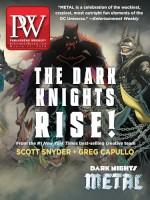In filmmaker and castle-restorer Weeks’s Sins of the Father (Poisoned Pen, Apr.), his second Countess of Prague mystery set in the early 20th century, Countess Beatrix “Trixie” von Falkenburg does some sleuthing on behalf of the Austro-Hungarian emperor, Franz-Josef I.
Why did you choose a countess as your protagonist?
Someone from the upper echelons can speak to anyone, high or low. She’s a countess rather than a count, in part because I respect and admire the abilities of many women I’ve met. I’ve also tried to catch that element of multitasking that all women possess. In male adventures, the man just gets on with the quest regardless of anything or anyone else. For a woman in her position, it’s different—and Trixie has to mix her adventures with thinking about clothes, her damned husband, her urchins—and other people’s feelings, as well as what color she’ll next paint the drawing room.
Why did you give the countess a real-life cold case to solve, the murder- suicide of Crown Prince Rudolf and his mistress at Mayerling in 1889?
The Mayerling tragedy has aspects that are still baffling, and Rudolf’s attempt to shoot his father the year before is still only a footnote in most histories. I wanted Trixie to turn her talents to his case, and her explanation fits all the available evidence. I hope I’ve seamlessly melded the real and the fictional in this story. I aim to produce nothing that fact can immediately contradict; Rudolf’s “black book” is real, for example, and is quoted.
What drew you to Prague, both to live and to use as a setting for your mystery novels?
I was asked to come there in 1994 to meet with the relevant ministries, so that I could look at the country’s “castle problem.” Due to communism, there were over 600 abused castles—that is, either derelict or inappropriately used. By 2003, I had decided to move to the city—a place where history is everywhere. As for the novels, I was particularly attracted to the Belle Époque, those years when Paris, Vienna, and Prague were the epicenters of style, culture, and fashion in all of Europe, and all of Europe was accessible and at peace.
What was the first castle you restored?
My own castle, bought with the money earned from my first films. I chose a real medieval one, the tower of which had been built around 1129, on the border of England and Wales. I restored a virtual ruin to be a wonderful home, shared willingly with the enthusiastic public, which I sold in 2003 in order to finance my move to Prague. Since the castle had been lived in since the 12th century, it was proved to be “Wales’s oldest lived-in castle.” Friends, seeing their breath in the air while at dinner, used to call it “Wales’s coldest lived-in castle.” But that was all part of its charm.



 Volume 265
Issue 11
03/12/2018
Volume 265
Issue 11
03/12/2018





